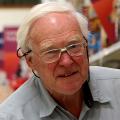
TWO pairs of discreet wooden markers about a mile apart on Castleton Rigg in the North York Moors are the key to discovering a striking new feature of the national park.
The vague tracks through the heather from these points will take you to the Seated Man, a bronze figure gazing out over Westerdale.
He’s a good deal less discreet than those foot-high markers that guide you to him.
Even hunched on his camping stool, he towers to almost 11ft. How did he get there – and why has he come?
If his arrival was well signalled in advance, well, there are many who take a close interest in the Moors, myself included, who knew nothing of him until after his arrival on June 20.
Presumably welcomed by the landowner, he was commissioned by the David Ross Foundation, a London-based charity whose introductory statement on its website declares its “firm belief that every child and young person has passions and talents. The Foundation aims to help them discover their strengths by offering a wide range of educational opportunities.”
Hmm… No clue there to the meaning of Seated Man for the Moors – and not much more when the Foundation adds that its “primary interests are in the arts, community, education, music and sport and enabling disadvantaged people to participate fully in society.”
Never mind. It’s hard to suppose that the national park authority didn’t give Seated Man the nod. If it did you’d have to ask what it was thinking about. The special glory of the Moors is indeed its vast sweeps of heather moor, the largest tract in England.
Rolling away to distant horizons they bear all kind of man made features: Bronze Age burial mounds, medieval crosses, ancient boundary stones.
All these are deeply rooted in the history of the region. So too are more prominent landmarks, like the castellated shooting box at Levisham and Capt Cook’s monument, honouring the region’s greatest son.
What relevance has Seated Man to the Moors? None. He clutches what looks like a doctor’s Gladstone bag. His strained expression suggests he is not even enjoying the lovely prospect of Westerdale spread beyond his smart shoes. The moors are best left to speak for themselves, with the history they have accumulated over time.
But if an appropriate figure was wanted it could have been a hill farmer, with dog and stick, a gamekeeper or, best of all, a rucksacked walker, symbolising the prime purpose of the national park – its conservation for people to enjoy in ways compatible with its character and atmosphere.
But Seated Man looks like being popular.
On my midweek trek to him I spoke to a score or so of other visitors. None disliked the figure. “He’s lovely”, said one woman.
An agreed stay of five years (agreed by whom?) will probably be followed by pressure for him to stay. And yet – the comment closest to criticism made to me was a wish by one man for an information board. “Why is he here?” he asked.
Yes, the key question. At his studio in Hampshire sculptor Sean Henry specialises in Seated Men. His latest has found an enviable home on the Moors. But is it fitting?
Shouldn’t this Man in the Moors be also a Man of the Moors?



Comments: Our rules
We want our comments to be a lively and valuable part of our community - a place where readers can debate and engage with the most important local issues. The ability to comment on our stories is a privilege, not a right, however, and that privilege may be withdrawn if it is abused or misused.
Please report any comments that break our rules.
Read the rules here